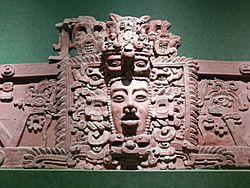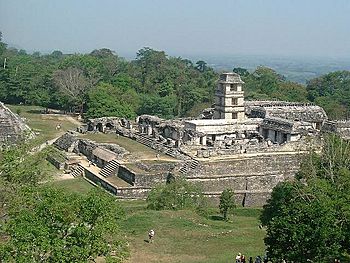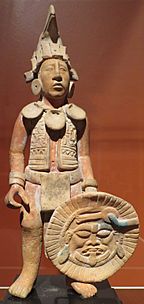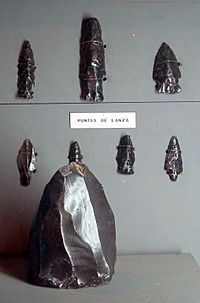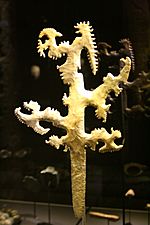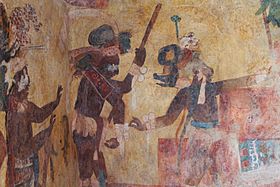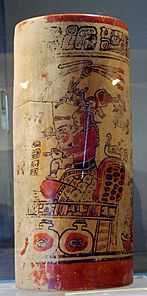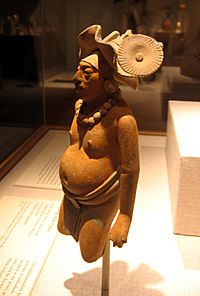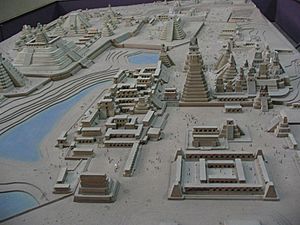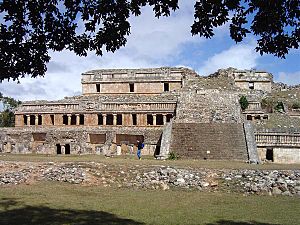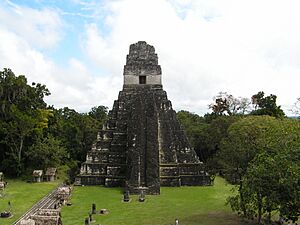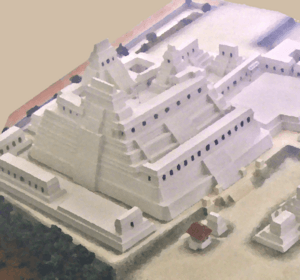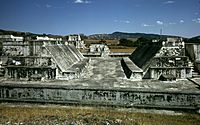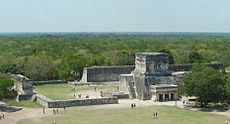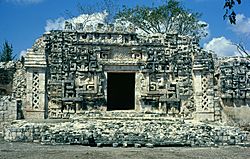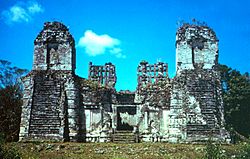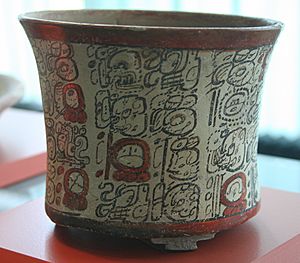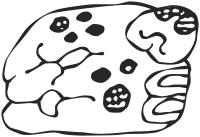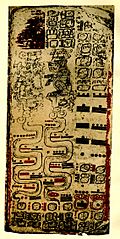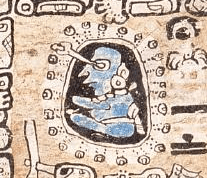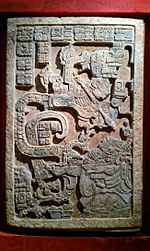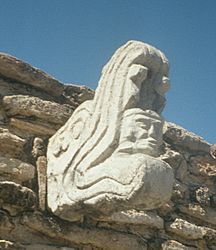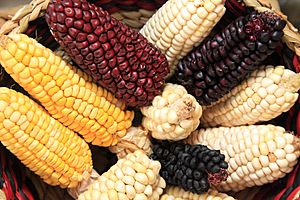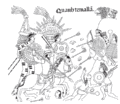Mayan civilization facts for kids
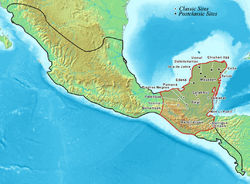
The Maya civilization and Mayan religion. They lived there for a long time and some of the Maya people live there even today.
The Mayans lived there 4,000 years ago (about 2000 BC). At that date, complex societies were living in the Mayan region. The staple foods of the Maya diet were cultivated. Their food included maize, beans, squashes, and chili peppers. The first Maya cities developed around 750 BC.
The Mayan people used a written language and a numeral system. They were good at art, building, and their priests studied stars and planets, which helped them make calendars.
The Mayan civilisation was biggest between the years of 420 AD and 900 AD. The Mayan civilisation spread all the way from central Mexico to Honduras, Guatemala, and northern El Salvador. It is estimated that at its maximum, the civilization had at least ten million people. The Maya people traded with other people in the Americas. Their art and buildings have many different styles. This shows they traded a lot. They made changes to their buildings to make them even better. The Maya civilization started getting smaller after 900 AD.
The Conquistadors arrived in the 15th century and took over Mexico and later Central America, even in the Mayann areas. However, the Maya people still live there today. They live in the same areas the Mayan civilization used to live in. They keep the old Mayan traditions and beliefs. There are many Mayan languages still spoken today, including one called the Achi language. A play called Rabinal Achi is considered important.
Contents
Location
The people of the Maya civilization lived in three different areas: the southern Maya highlands, the central lowlands, and the northern lowlands. They had many different types of land, including mountains and dry plains. People living in the low plains by the sea were affected by hurricanes and tropical storms from the Caribbean.
The area covered what we now call the southern Mexican states of Chiapas and Tabasco, and the Yucatán Peninsula states of Quintana Roo, Campeche and Yucatán. They also included where we now call Guatemala, Belize, El Salvador and western Honduras.
History
The pre-classical period
The first Maya settlements started about 1800 BC. They lived in the Soconusco region, now the state of Chiapas in Mexico, on the Pacific Ocean. This is called the "early pre-classic period" in Mayan history'. People in Central America had been nomads who went from place to place to find food and shelter. Around this time they began to settle down.They started to farm animals and make pottery and small clay figures. They buried their dead in simple burial mounds. Later they started to make these mounds into step pyramids.
There were other people around at the time, especially in the north. The Olmec, the Mixe-Zoque, and Zapotec civilizations mostly lived in the area we now call Oaxaca. We don't know exactly where the borders of the Maya civilization were. Many of the most important early examples of writing and buildings appeared in north, so these cultures probably affected the Maya civilization.
The classical period
From about 250 to 909, the Maya civilization built many monuments and cities, and made many important carvings. The "southern lowlands" were an important place at the time. The Maya civilization made many discoveries about art and thinking there.
Like Ancient Greece, their civilization was made up of numerous cities, which all worked in different ways. People gathered around these cities to farm. Well-known cities were Tikal, Palenque, Copán and Calakmul. Lesser-known cities were Dos Pilas, Uaxactun, Altun Ha, and Bonampak, among others. In general, we know more about where the cities were in the south than we do in the north. Some northern cities we do know about were Oxkintok, Chunchucmil, and Uxmal.
Their most famous monuments are the pyramids they built as part of their religious centers, and the palaces. The palace at Cancuén is the largest we know about in the Maya area. The Maya also made carved stone slabs which they called tetun, or "tree-stones". These slabs show rulers along with hieroglyphic writing describing their family, military victories, and other things that they did well.
Trade with other civilizations
The Maya had trade routes that ran over long distances. They traded with many other Mesoamerican cultures, such as Teotihuacan, the Zapotec, and other groups in central and gulf-coast Mexico. They also traded with groups that were farther away. For example, people who study the Maya civilization found gold from Panama in the Sacred well at Chichen Itza.
Some important things they traded were cacao, salt, sea shells, jade and obsidian.
Sudden collapse
Between 900 AD and 1000 AD, the cities in the southern lowlands had more and more problems until all the people left. The Maya civilization there stopped making big monuments and carvings. People who study the Maya civilization are not sure why this happened. They have many different ideas - some people think there was a big environmental disaster, or a disease affected a lot of people, or there were just too many people for the amount of food they could grow.
Post-classical period and decline
In the north, the Maya civilization kept going. Other cultures started mixing with Mayan culture much more. Some of the important sites in this time were Chichen Itza, Uxmal, Edzná, and Coba. At some point, the families who ruled over Chichen and Uxmal got weaker and the rulers in the city of Mayapan ruled all of the Mayan civilization in the Yucatán peninsula until there was a revolt in 1450. After the revolt, the whole area broke up into different cities who fought against each other, until the Spanish conquest of Yucatán.
The Itza Maya, Ko'woj, and Yalain groups around what is now Guatamela were still around, but there were not very many of them. By 1520, they had built themselves back up again and started to build cities. The Itza had their capital at Tayasal (also known as Noh Petén), and people who study the Maya civlisation think what's left of this city is below the modern city of Flores, Guatemala on Lake Petén Itzá. The Ko'woj had their capital at Zacpeten. Some Mayan cultures were still living in the southern highlands.
The Quiché kingdom produced the most famous Mayan work, the Popol Vuh. It talks about the creation of the world, the Mayan gods and goddesses, how humans and animals were created and why the Quiché kingdom was the best one in the Maya civilization.
The Spanish started to conquer Maya lands. It took them a long time (170 years) to finish doing this because the Mayans had no capital city and each city had a different culture. The last Mayan states, the Itza city of Tayasal and the Ko'woj city of Zacpeten, still had people living in them late into the 17th century. They were finally conquered in 1697.
Society
From the Early Preclassic, Maya society was sharply divided between the elite and commoners. As population increased over time, various sectors of society became increasingly specialised, and political organization increasingly complex. By the Late Classic, when populations had grown enormously and hundreds of cities were connected in a complex web of political hierarchies, the wealthy segment of society multiplied. A middle class may have developed that included artisans, low ranking priests and officials, merchants, and soldiers. Commoners included farmers, servants, labourers, and slaves. According to indigenous histories, land was held communally by noble houses or clans. Such clans held that the land was the property of the ancestors, and ties between the land and the ancestors were reinforced by the burial of the dead within residential compounds.
King and court
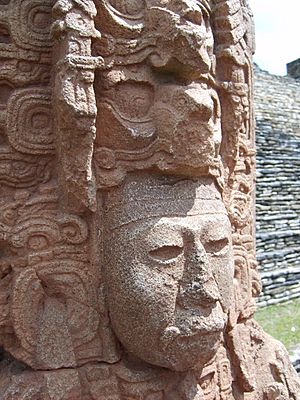
Classic Maya rule was centred in a royal culture that was displayed in all areas of Classic Maya art. The king was the supreme ruler and held a semi-divine status that made him the mediator between the mortal realm and that of the gods. From very early times, kings were specifically identified with the young maize god, whose gift of maize was the basis of Mesoamerican civilization. Maya royal succession was patrilineal, and royal power only passed to queens when doing otherwise would result in the extinction of the dynasty. Typically, power was passed to the eldest son. A young prince was called a chʼok ("youth"), although this word later came to refer to nobility in general. The royal heir was called bʼaah chʼok ("head youth"). Various points in the prince's childhood were marked by ritual; the most important was a bloodletting ceremony at age five or six. Although being of the royal bloodline was of utmost importance, the heir also had to be a successful war leader, as demonstrated by taking of captives. The enthronement of a new king was a highly elaborate ceremony, involving a series of separate acts that included enthronement upon a jaguar-skin cushion, human sacrifice, and receiving the symbols of royal power, such as a headband bearing a jade representation of the so-called "jester god", an elaborate headdress adorned with quetzal feathers, and a sceptre representing the god Kʼawiil.
Maya political administration, based around the royal court, was not bureaucratic in nature. Government was hierarchical, and official posts were sponsored by higher-ranking members of the aristocracy; officials tended to be promoted to higher levels of office over their lives. Officials are referred to as being "owned" by their sponsor, and this relationship continued even after the death of the sponsor. The Maya royal court was a vibrant and dynamic political institution. There was no universal structure for the Maya royal court, instead each polity formed a royal court that was suited to its own individual context. A number of royal and noble titles have been identified by epigraphers translating Classic Maya inscriptions. Ajaw is usually translated as "lord" or "king". In the Early Classic, an ajaw was the ruler of a city. Later, with increasing social complexity, the ajaw was a member of the ruling class and a major city could have more than one, each ruling over different districts. Paramount rulers distinguished themselves from the extended nobility by prefixing the word kʼuhul to their ajaw title. A kʼuhul ajaw was "divine lord", originally confined to the kings of the most prestigious and ancient royal lines. Kalomte was a royal title, whose exact meaning is not yet deciphered, but it was held only by the most powerful kings of the strongest dynasties. It indicated an overlord, or high king, and was only in use during the Classic period. By the Late Classic, the absolute power of the kʼuhul ajaw had weakened, and the political system had diversified to include a wider aristocracy, that by this time may well have expanded disproportionately.
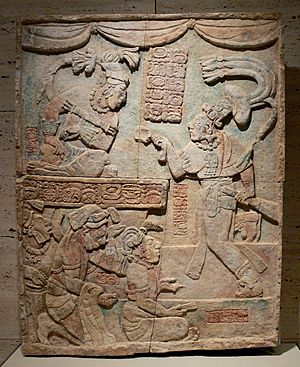
A sajal was ranked below the ajaw, and indicated a subservient lord. A sajal would be lord of a second- or third-tier site, answering to an ajaw, who may himself have been subservient to a kalomte. A sajal would often be a war captain or regional governor, and inscriptions often link the sajal title to warfare; they are often mentioned as the holders of war captives. Sajal meant "feared one". The titles of ah tzʼihb and ah chʼul hun are both related to scribes. The ah tzʼihb was a royal scribe, usually a member of the royal family; the ah chʼul hun was the Keeper of the Holy Books, a title that is closely associated with the ajaw title, indicating that an ajaw always held the ah chʼul hun title simultaneously. Other courtly titles, the functions of which are not well understood, were yajaw kʼahk' ("Lord of Fire"), tiʼhuun and ti'sakhuun. These last two may be variations on the same title, and Mark Zender has suggested that the holder of this title may have been the spokesman for the ruler. Courtly titles are overwhelmingly male-oriented, and in those relatively rare occasions where they are applied to a woman, they appear to be used as honorifics for female royalty. Titled elites were often associated with particular structures in the hieroglyphic inscriptions of Classic period cities, indicating that such office holders either owned that structure, or that the structure was an important focus for their activities. A lakam, or standard-bearer, was possibly the only non-elite post-holder in the royal court. The lakam was only found in larger sites, and they appear to have been responsible for the taxation of local districts.
Different factions may have existed in the royal court. The kʼuhul ahaw and his household would have formed the central power-base, but other important groups were the priesthood, the warrior aristocracy, and other aristocratic courtiers. Where ruling councils existed, as at Chichen Itza and Copán, these may have formed an additional faction. Rivalry between different factions would have led to dynamic political institutions as compromises and disagreements were played out. In such a setting, public performance was vital. Such performances included ritual dances, presentation of war captives, offerings of tribute, human sacrifice, and religious ritual.
Commoners
Commoners are estimated to have comprised over 90% of the population, but relatively little is known about them. Their houses were generally constructed from perishable materials, and their remains have left little trace in the archaeological record. Some commoner dwellings were raised on low platforms, and these can be identified, but an unknown quantity of commoner houses were not. Such low-status dwellings can only be detected by extensive remote-sensing surveys of apparently empty terrain. The range of commoners was broad; it consisted of everyone not of noble birth, and therefore included everyone from the poorest farmers to wealthy craftsmen and commoners appointed to bureaucratic positions. Commoners engaged in essential production activities, including that of products destined for use by the elite, such as cotton and cacao, as well as subsistence crops for their own use, and utilitarian items such as ceramics and stone tools. Commoners took part in warfare, and could advance socially by proving themselves as outstanding warriors. Commoners paid taxes to the elite in the form of staple goods such as maize, flour and game. It is likely that hard-working commoners who displayed exceptional skills and initiative could become influential members of Maya society.
Warfare
Warfare was prevalent in the Maya world. Military campaigns were launched for a variety of reasons, including the control of trade routes and tribute, raids to take captives, scaling up to the complete destruction of an enemy state. Little is known about Maya military organization, logistics, or training. Warfare is depicted in Maya art from the Classic period, and wars and victories are mentioned in hieroglyphic inscriptions. Unfortunately, the inscriptions do not provide information upon the causes of war, or the form it took. In the 8th–9th centuries, intensive warfare resulted in the collapse of the kingdoms of the Petexbatún region of western Petén. The rapid abandonment of Aguateca by its inhabitants has provided a rare opportunity to examine the remains of Maya weaponry in situ. Aguateca was stormed by unknown enemies around 810 AD, who overcame its formidable defences and burned the royal palace. The elite inhabitants of the city either fled or were captured, and never returned to collect their abandoned property. The inhabitants of the periphery abandoned the site soon after. This is an example of intensive warfare carried out by an enemy in order to eliminate a Maya state, rather than subjugate it. Research at Aguateca indicated that Classic period warriors were primarily members of the elite.
From as early as the Preclassic period, the ruler of a Maya polity was expected to be a distinguished war leader, and was depicted with trophy heads hanging from his belt. In the Classic period, such trophy heads no longer appeared on the king's belt, but Classic period kings are frequently depicted standing over humiliated war captives. Right up to the end of the Postclassic period, Maya kings led as war captains. Maya inscriptions from the Classic show that a defeated king could be captured and sacrificed. The Spanish recorded that Maya leaders kept track of troop movements in painted books.
The outcome of a successful military campaign could vary in its impact on the defeated polity. In some cases, entire cities were sacked, and never resettled, as at Aguateca. In other instances, the victors would seize the defeated rulers, their families, and patron gods. The captured nobles and their families could be imprisoned, or sacrificed. At the least severe end of the scale, the defeated polity would be obliged to pay tribute to the victor.
Warriors
During the Contact period, certain military positions were held by members of the aristocracy, and were passed on by patrilineal succession. It is likely that the specialised knowledge inherent in the particular military role was taught to the successor, including strategy, ritual, and war dances. Maya armies of the Contact period were highly disciplined, and warriors participated in regular training exercises and drills; every able-bodied adult male was available for military service. Maya states did not maintain standing armies; warriors were mustered by local officials who reported back to appointed warleaders. There were also units of full-time mercenaries who followed permanent leaders. Most warriors were not full-time, however, and were primarily farmers; the needs of their crops usually came before warfare. Maya warfare was not so much aimed at destruction of the enemy as the seizure of captives and plunder.
There is some evidence from the Classic period that women provided supporting roles in war, but they did not act as military officers with the exception of those rare ruling queens. By the Postclassic, the native chronicles suggest that women occasionally fought in battle.
Weapons
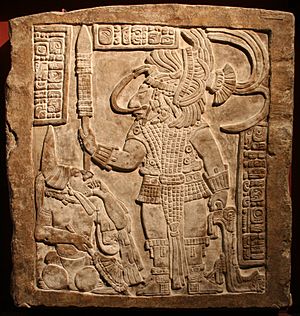
The atlatl (spear-thrower) was introduced to the Maya region by Teotihuacan in the Early Classic. This was a 0.5-metre-long (1.6 ft) stick with a notched end to hold a dart or javelin. The stick was used to launch the missile with more force and accuracy than simply hurling it with the arm. Evidence in the form of stone blade points recovered from Aguateca indicate that darts and spears were the primary weapons of the Classic Maya warrior. Commoners used blowguns in war, which also served as their hunting weapon. The bow and arrow was used by the ancient Maya for both war and hunting. Although present in the Maya region during the Classic period, its use as a weapon of war was not favoured; it did not become a common weapon until the Postclassic. The Contact period Maya also used two-handed swords crafted from strong wood with the blade fashioned from inset obsidian, similar to the Aztec macuahuitl. Maya warriors wore body armour in the form of quilted cotton that had been soaked in salt water to toughen it; the resulting armour compared favourably to the steel armour worn by the Spanish when they conquered the region. Warriors bore wooden or animal hide shields decorated with feathers and animal skins.
Trade
Trade was a key component of Maya society, and in the development of the Maya civilization. The cities that grew to become the most important usually controlled access to vital trade goods, or portage routes. Cities such as Kaminaljuyu and Qʼumarkaj in the Guatemalan Highlands, and Chalchuapa in El Salvador, variously controlled access to the sources of obsidian at different points in Maya history. The Maya were major producers of cotton, which was used to make the textiles to be traded throughout Mesoamerica. The most important cities in the northern Yucatán Peninsula controlled access to the sources of salt. In the Postclassic, the Maya engaged in a flourishing slave trade with wider Mesoamerica.
The Maya engaged in long-distance trade across the Maya region, and across greater Mesoamerica and beyond. As an illustration, an Early Classic Maya merchant quarter has been identified at the distant metropolis of Teotihuacan, in central Mexico. Within Mesoamerica beyond the Maya area, trade routes particularly focused on central Mexico and the Gulf coast. In the Early Classic, Chichen Itza was at the hub of an extensive trade network that imported gold discs from Colombia and Panama, and turquoise from Los Cerrillos, New Mexico. Long-distance trade of both luxury and utilitarian goods was probably controlled by the royal family. Prestige goods obtained by trade were used both for consumption by the city's ruler, and as luxury gifts to consolidate the loyalty of vassals and allies.
Trade routes not only supplied physical goods, they facilitated the movement of people and ideas throughout Mesoamerica. Shifts in trade routes occurred with the rise and fall of important cities in the Maya region, and have been identified in every major reorganization of the Maya civilization, such as the rise of Preclassic Maya civilization, the transition to the Classic, and the Terminal Classic collapse. Even the Spanish Conquest did not immediately terminate all Maya trading activity; for example, the Contact period Manche Chʼol traded the prestige crops of cacao, annatto and vanilla into colonial Verapaz.
Merchants
Little is known of Maya merchants, although they are depicted on Maya ceramics in elaborate noble dress, so at least some were members of the elite. During the Contact period, Maya nobility took part in long-distance trading expeditions. The majority of traders were middle class, but were largely engaged in local and regional trade rather than the prestigious long-distance trading that was the preserve of the elite. The travelling of merchants into dangerous foreign territory was likened to a passage through the underworld; the patron deities of merchants were two underworld gods carrying backpacks. When merchants travelled, they painted themselves black, like their patron gods, and went heavily armed.
The Maya had no pack animals, so all trade goods were carried on the backs of porters when going overland; if the trade route followed a river or the coast, then goods were transported in canoes. A substantial Maya trading canoe made from a large hollowed-out tree trunk was encountered off Honduras on Christopher Columbus's fourth voyage. The canoe was 2.5 metres (8.2 ft) broad and was powered by 25 rowers. Trade goods carried included cacao, obsidian, ceramics, textiles, and copper bells and axes. Cacao was used as currency (although not exclusively), and its value was such that counterfeiting occurred by removing the flesh from the pod, and stuffing it with dirt or avocado rind.
Marketplaces
Marketplaces are difficult to identify archaeologically. However, the Spanish reported a thriving market economy when they arrived in the region. At some Classic period cities, archaeologists have tentatively identified formal arcade-style masonry architecture and parallel alignments of scattered stones as the permanent foundations of market stalls. A 2007 study compared soils from a modern Guatemalan market to a proposed ancient market at Chunchucmil; unusually high levels of zinc and phosphorus at both sites indicated similar food production and vegetable sales activity. The calculated density of market stalls at Chunchucmil strongly suggests that a thriving market economy already existed in the Early Classic. Archaeologists have tentatively identified marketplaces at an increasing number of Maya cities by means of a combination of archaeology and soil analysis. When the Spanish arrived, Postclassic cities in the highlands had markets in permanent plazas, with officials on hand to settle disputes, enforce rules, and collect taxes.
Art
Maya art is essentially the art of the royal court. It is almost exclusively concerned with the Maya elite and their world. Maya art was crafted from both perishable and non-perishable materials, and served to link the Maya to their ancestors. Although surviving Maya art represents only a small proportion of the art that the Maya created, it represents a wider variety of subjects than any other art tradition in the Americas. Maya art has many regional styles, and is unique in the ancient Americas in bearing narrative text. The finest surviving Maya art dates to the Late Classic period.
The Maya exhibited a preference for the colour green or blue-green, and used the same word for the colours blue and green. Correspondingly, they placed high value on apple-green jade, and other greenstones, associating them with the sun-god Kʼinich Ajau. They sculpted artefacts that included fine tesserae and beads, to carved heads weighing 4.42 kilograms (9.7 lb). The Maya nobility practised dental modification, and some lords wore encrusted jade in their teeth. Mosaic funerary masks could also be fashioned from jade, such as that of Kʼinich Janaabʼ Pakal, king of Palenque.
Maya stone sculpture emerged into the archaeological record as a fully developed tradition, suggesting that it may have evolved from a tradition of sculpting wood. Because of the biodegradability of wood, the corpus of Maya woodwork has almost entirely disappeared. The few wooden artefacts that have survived include three-dimensional sculptures, and hieroglyphic panels. Stone Maya stelae are widespread in city sites, often paired with low, circular stones referred to as altars in the literature. Stone sculpture also took other forms, such as the limestone relief panels at Palenque and Piedras Negras. At Yaxchilan, Dos Pilas, Copán, and other sites, stone stairways were decorated with sculpture. The hieroglyphic stairway at Copán comprises the longest surviving Maya hieroglyphic text, and consists of 2,200 individual glyphs.
The largest Maya sculptures consisted of architectural façades crafted from stucco. The rough form was laid out on a plain plaster base coating on the wall, and the three-dimensional form was built up using small stones. Finally, this was coated with stucco and moulded into the finished form; human body forms were first modelled in stucco, with their costumes added afterwards. The final stucco sculpture was then brightly painted. Giant stucco masks were used to adorn temple façades by the Late Preclassic, and such decoration continued into the Classic period.
The Maya had a long tradition of mural painting; rich polychrome murals have been excavated at San Bartolo, dating to between 300 and 200 BC. Walls were coated with plaster, and polychrome designs were painted onto the smooth finish. The majority of such murals have not survived, but Early Classic tombs painted in cream, red, and black have been excavated at Caracol, Río Azul, and Tikal. Among the best preserved murals are a full-size series of Late Classic paintings at Bonampak.
Flint, chert, and obsidian all served utilitarian purposes in Maya culture, but many pieces were finely crafted into forms that were never intended to be used as tools. Eccentric flints are among the finest lithic artefacts produced by the ancient Maya. They were technically very challenging to produce, requiring considerable skill on the part of the artisan. Large obsidian eccentrics can measure over 30 centimetres (12 in) in length. Their actual form varies considerably but they generally depict human, animal and geometric forms associated with Maya religion. Eccentric flints show a great variety of forms, such as crescents, crosses, snakes, and scorpions. The largest and most elaborate examples display multiple human heads, with minor heads sometimes branching off from larger one.
Maya textiles are very poorly represented in the archaeological record, although by comparison with other pre-Columbian cultures, such as the Aztecs and the Andean region, it is likely that they were high-value items. Scraps of textile have been recovered, but the best evidence for textile art is where they are represented in other media, such as painted murals or ceramics. Such secondary representations show the elite of the Maya court adorned with sumptuous cloths, generally these would have been cotton, but jaguar pelts and deer hides are also shown.
Ceramics are the most commonly surviving type of Maya art. The Maya had no knowledge of the potter's wheel, and Maya vessels were built up by coiling rolled strips of clay into the desired form. Maya pottery was not glazed, although it often had a fine finish produced by burnishing. Maya ceramics were painted with clay slips blended with minerals and coloured clays. Ancient Maya firing techniques have yet to be replicated. A quantity of extremely fine ceramic figurines have been excavated from Late Classic tombs on Jaina Island, in northern Yucatán. They stand from 10 to 25 centimetres (3.9 to 9.8 in) high and were hand modelled, with exquisite detail. The Ik-style polychrome ceramic corpus, including finely painted plates and cylindrical vessels, originated in Late Classic Motul de San José. It includes a set of features such as hieroglyphs painted in a pink or pale red colour and scenes with dancers wearing masks. One of the most distinctive features is the realistic representation of subjects as they appeared in life. The subject matter of the vessels includes courtly life from the Petén region in the 8th century AD, such as diplomatic meetings, feasting, bloodletting, scenes of warriors and the sacrifice of prisoners of war.
Bone, both human and animal, was also sculpted; human bones may have been trophies, or relics of ancestors. The Maya valued Spondylus shells, and worked them to remove the white exterior and spines, to reveal the fine orange interior. Around the 10th century AD, metallurgy arrived in Mesoamerica from South America, and the Maya began to make small objects in gold, silver and copper. The Maya generally hammered sheet metal into objects such as beads, bells, and discs. In the last centuries before the Spanish Conquest, the Maya began to use the lost-wax method to cast small metal pieces.
One poorly studied area of Maya folk art is graffiti. Additional graffiti, not part of the planned decoration, was incised into the stucco of interior walls, floors, and benches, in a wide variety of buildings, including temples, residences, and storerooms. Graffiti has been recorded at 51 Maya sites, particularly clustered in the Petén Basin and southern Campeche, and the Chenes region of northwestern Yucatán. At Tikal, where a great quantity of graffiti has been recorded, the subject matter includes drawings of temples, people, deities, animals, banners, litters, and thrones. Graffiti was often inscribed haphazardly, with drawings overlapping each other, and display a mix of crude, untrained art, and examples by artists familiar with Classic-period artistic conventions.
Architecture
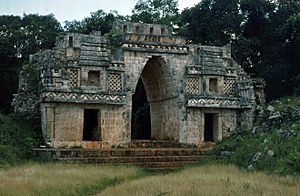
The Maya produced a vast array of structures, and have left an extensive architectural legacy. Maya architecture also incorporates various art forms and hieroglyphic texts. Masonry architecture built by the Maya evidences craft specialization in Maya society, centralised organization and the political means to mobilize a large workforce. It is estimated that a large elite residence at Copán required an estimated 10,686 man-days to build, which compares to 67-man-days for a commoner's hut. It is further estimated that 65% of the labour required to build the noble residence was used in the quarrying, transporting, and finishing of the stone used in construction, and 24% of the labour was required for the manufacture and application of limestone-based plaster. Altogether, it is estimated that two to three months were required for the construction of the residence for this single noble at Copán, using between 80 and 130 full-time labourers. A Classic-period city like Tikal was spread over 20 square kilometres (7.7 sq mi), with an urban core covering 6 square kilometres (2.3 sq mi). The labour required to build such a city was immense, running into many millions of man-days. The most massive structures ever erected by the Maya were built during the Preclassic period. Craft specialization would have required dedicated stonemasons and plasterers by the Late Preclassic, and would have required planners and architects.
Urban design
Maya cities were not formally planned, and were subject to irregular expansion, with the haphazard addition of palaces, temples and other buildings. Most Maya cities tended to grow outwards from the core, and upwards as new structures were superimposed upon preceding architecture. Maya cities usually had a ceremonial and administrative centre surrounded by a vast irregular sprawl of residential complexes. The centres of all Maya cities featured sacred precincts, sometimes separated from nearby residential areas by walls. These precincts contained pyramid temples and other monumental architecture dedicated to elite activities, such as basal platforms that supported administrative or elite residential complexes. Sculpted monuments were raised to record the deeds of the ruling dynasty. City centres also featured plazas, sacred ballcourts and buildings used for marketplaces and schools. Frequently causeways linked the centre to outlying areas of the city. Some of these classes of architecture formed lesser groups in the outlying areas of the city, which served as sacred centres for non-royal lineages. The areas adjacent to these sacred compounds included residential complexes housing wealthy lineages. The largest and richest of these elite compounds sometimes possessed sculpture and art of craftsmanship equal to that of royal art.
The ceremonial centre of the Maya city was where the ruling elite lived, and where the administrative functions of the city were performed, together with religious ceremonies. It was also where the inhabitants of the city gathered for public activities. Elite residential complexes occupied the best land around the city centre, while commoners had their residences dispersed further away from the ceremonial centre. Residential units were built on top of stone platforms to raise them above the level of the rain season floodwaters.
Building materials and methods

The Maya built their cities with Neolithic technology; they built their structures from both perishable materials and from stone. The exact type of stone used in masonry construction varied according to locally available resources, and this also affected the building style. Across a broad swathe of the Maya area, limestone was immediately available. The local limestone is relatively soft when freshly cut, but hardens with exposure. There was great variety in the quality of limestone, with good-quality stone available in the Usumacinta region; in the northern Yucatán, the limestone used in construction was of relatively poor quality. Volcanic tuff was used at Copán, and nearby Quiriguá employed sandstone. In Comalcalco, where suitable stone was not available locally, fired bricks were employed. Limestone was burned at high temperatures in order to manufacture cement, plaster, and stucco. Lime-based cement was used to seal stonework in place, and stone blocks were fashioned using rope-and-water abrasion, and with obsidian tools. The Maya did not employ a functional wheel, so all loads were transported on litters, barges, or rolled on logs. Heavy loads were lifted with rope, but probably without employing pulleys.
Wood was used for beams, and for lintels, even in masonry structures. Throughout Maya history, common huts and some temples continued to be built from wooden poles and thatch. Adobe was also applied; this consisted of mud strengthened with straw and was applied as a coating over the woven-stick walls of huts, even after the development of masonry structures. In the southern Maya area, adobe was employed in monumental architecture when no suitable stone was locally available.
Principal construction types
The great cities of the Maya civilization were composed of pyramid temples, palaces, ballcourts, sacbeob (causeways), patios and plazas. Some cities also possessed extensive hydraulic systems or defensive walls. The exteriors of most buildings were painted, either in one or multiple colours, or with imagery. Many buildings were adorned with sculpture or painted stucco reliefs.
Palaces and acropoleis
These complexes were usually located in the site core, beside a principal plaza. Maya palaces consisted of a platform supporting a multiroom range structure. The term acropolis, in a Maya context, refers to a complex of structures built upon platforms of varying height. Palaces and acropoleis were essentially elite residential compounds. They generally extended horizontally as opposed to the towering Maya pyramids, and often had restricted access. Some structures in Maya acropoleis supported roof combs. Rooms often had stone benches for sleeping, and holes indicate where curtains once hung. Large palaces, such as at Palenque, could be fitted with a water supply, and sweat baths were often found within the complex, or nearby. During the Early Classic, rulers were sometimes buried underneath the acropolis complex. Some rooms in palaces were true throne rooms; in the royal palace of Palenque there were a number of throne rooms that were used for important events, including the inauguration of new kings.
Palaces are usually arranged around one or more courtyards, with their façades facing inwards; some examples are adorned with sculpture. Some palaces possess associated hieroglyphic descriptions that identify them as the royal residences of named rulers. There is abundant evidence that palaces were far more than simple elite residences, and that a range of courtly activities took place in them, including audiences, formal receptions, and important rituals.
Pyramids and temples
Temples were sometimes referred to in hieroglyphic texts as kʼuh nah, meaning "god's house". Temples were raised on platforms, most often upon a pyramid. The earliest temples were probably thatched huts built upon low platforms. By the Late Preclassic period, their walls were of stone, and the development of the corbel arch allowed stone roofs to replace thatch. By the Classic period, temple roofs were being topped with roof combs that extended the height of the temple and served as a foundation for monumental art. Temple shrines contained one to three rooms, and were dedicated to important deities. Such a deity might be one of the patron gods of the city, or a deified ancestor. In general, freestanding pyramids were shrines honouring powerful ancestors.
E-Groups and observatories
The Maya were keen observers of the sun, stars, and planets. E-Groups were a particular arrangement of temples that were relatively common in the Maya region; they take their names from Group E at Uaxactun. They consisted of three small structures facing a fourth structure, and were used to mark the solstices and equinoxes. The earliest examples date to the Preclassic period. The Lost World complex at Tikal started out as an E-Group built towards the end of the Middle Preclassic. Due to its nature, the basic layout of an E-Group was constant. A structure was built on the west side of a plaza; it was usually a radial pyramid with stairways facing the cardinal directions. It faced east across the plaza to three small temples on the far side. From the west pyramid, the sun was seen to rise over these temples on the solstices and equinoxes. E-Groups were raised across the central and southern Maya area for over a millennium; not all were properly aligned as observatories, and their function may have been symbolic.
As well as E-Groups, the Maya built other structures dedicated to observing the movements of celestial bodies. Many Maya buildings were aligned with astronomical bodies, including the planet Venus, and various constellations. The Caracol structure at Chichen Itza was a circular multi-level edifice, with a conical superstructure. It has slit windows that marked the movements of Venus. At Copán, a pair of stelae were raised to mark the position of the setting sun at the equinoxes.
Triadic pyramids
Triadic pyramids first appeared in the Preclassic. They consisted of a dominant structure flanked by two smaller inward-facing buildings, all mounted upon a single basal platform. The largest known triadic pyramid was built at El Mirador in the Petén Basin; it covers an area six times as large as that covered by Temple IV, the largest pyramid at Tikal. The three superstructures all have stairways leading up from the central plaza on top of the basal platform. No securely established forerunners of Triadic Groups are known, but they may have developed from the eastern range building of E-Group complexes. The triadic form was the predominant architectural form in the Petén region during the Late Preclassic. Examples of triadic pyramids are known from as many as 88 archaeological sites. At Nakbe, there are at least a dozen examples of triadic complexes and the four largest structures in the city are triadic in nature. At El Mirador there are probably as many as 36 triadic structures. Examples of the triadic form are even known from Dzibilchaltun in the far north of the Yucatán Peninsula, and Qʼumarkaj in the Highlands of Guatemala. The triadic pyramid remained a popular architectural form for centuries after the first examples were built; it continued in use into the Classic Period, with later examples being found at Uaxactun, Caracol, Seibal, Nakum, Tikal and Palenque. The Qʼumarkaj example is the only one that has been dated to the Postclassic Period. The triple-temple form of the triadic pyramid appears to be related to Maya mythology.
Ballcourts
The ballcourt is a distinctive pan-Mesoamerican form of architecture. Although the majority of Maya ballcourts date to the Classic period, the earliest examples appeared around 1000 BC in northwestern Yucatán, during the Middle Preclassic. By the time of Spanish contact, ballcourts were only in use in the Guatemalan Highlands, at cities such as Qʼumarkaj and Iximche. Throughout Maya history, ballcourts maintained a characteristic form consisting of an ɪ shape, with a central playing area terminating in two transverse end zones. The central playing area usually measures between 20 and 30 metres (66 and 98 ft) long, and is flanked by two lateral structures that stood up to 3 or 4 metres (9.8 or 13.1 ft) high. The lateral platforms often supported structures that may have held privileged spectators. The Great Ballcourt at Chichen Itza is the largest in Mesoamerica, measuring 83 metres (272 ft) long by 30 metres (98 ft) wide, with walls standing 8.2 metres (27 ft) high.
Regional architectural styles
Although Maya cities shared many common features, there was considerable variation in architectural style. Such styles were influenced by locally available construction materials, climate, topography, and local preferences. In the Late Classic, these local differences developed into distinctive regional architectural styles.
Central Petén
The central Petén style of architecture is modelled after the great city of Tikal. The style is characterised by tall pyramids supporting a summit shrine adorned with a roof comb, and accessed by a single doorway. Additional features are the use of stela-altar pairings, and the decoration of architectural façades, lintels, and roof combs with relief sculptures of rulers and gods. One of the finest examples of Central Petén style architecture is Tikal Temple I. Examples of sites in the Central Petén style include Altun Ha, Calakmul, Holmul, Ixkun, Nakum, Naranjo, and Yaxhá.
Puuc
The exemplar of Puuc-style architecture is Uxmal. The style developed in the Puuc Hills of northwestern Yucatán; during the Terminal Classic it spread beyond this core region across the northern Yucatán Peninsula. Puuc sites replaced rubble cores with lime cement, resulting in stronger walls, and also strengthened their corbel arches; this allowed Puuc-style cities to build freestanding entrance archways. The upper façades of buildings were decorated with precut stones mosaic-fashion, erected as facing over the core, forming elaborate compositions of long-nosed deities such as the rain god Chaac and the Principal Bird Deity. The motifs also included geometric patterns, lattices and spools, possibly influenced by styles from highland Oaxaca, outside the Maya area. In contrast, the lower façades were left undecorated. Roof combs were relatively uncommon at Puuc sites.
Chenes
The Chenes style is very similar to the Puuc style, but predates the use of the mosaic façades of the Puuc region. It featured fully adorned façades on both the upper and lower sections of structures. Some doorways were surrounded by mosaic masks of monsters representing mountain or sky deities, identifying the doorways as entrances to the supernatural realm. Some buildings contained interior stairways that accessed different levels. The Chenes style is most commonly encountered in the southern portion of the Yucatán Peninsula, although individual buildings in the style can be found elsewhere in the peninsula. Examples of Chenes sites include Dzibilnocac, Hochob, Santa Rosa Xtampak, and Tabasqueño.
Río Bec
The Río Bec style forms a sub-region of the Chenes style, and also features elements of the Central Petén style, such as prominent roof combs. Its palaces are distinctive for their false-tower decorations, lacking interior rooms, with steep, almost vertical, stairways and false doors. These towers were adorned with deity masks, and were built to impress the viewer, rather than serve any practical function. Such false towers are only found in the Río Bec region. Río Bec sites include Chicanná, Hormiguero, and Xpuhil.
Usumacinta
The Usumacinta style developed in the hilly terrain of the Usumacinta drainage. Cities took advantage of the hillsides to support their major architecture, as at Palenque and Yaxchilan. Sites modified corbel vaulting to allow thinner walls and multiple access doors to temples. As in Petén, roof combs adorned principal structures. Palaces had multiple entrances that used post-and-lintel entrances rather than corbel vaulting. Many sites erected stelae, but Palenque instead developed finely sculpted panelling to decorate its buildings.
Language
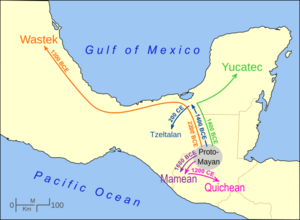
Before 2000 BC, the Maya spoke a single language, dubbed proto-Mayan by linguists. Linguistic analysis of reconstructed Proto-Mayan vocabulary suggests that the original Proto-Mayan homeland was in the western or northern Guatemalan Highlands, although the evidence is not conclusive. Proto-Mayan diverged during the Preclassic period to form the major Mayan language groups that make up the family, including Huastecan, Greater Kʼicheʼan, Greater Qʼanjobalan, Mamean, Tzʼeltalan-Chʼolan, and Yucatecan. These groups diverged further during the pre-Columbian era to form over 30 languages that have survived into modern times. The language of almost all Classic Maya texts over the entire Maya area has been identified as Chʼolan; Late Preclassic text from Kaminaljuyu, in the highlands, also appears to be in, or related to, Chʼolan. The use of Chʼolan as the language of Maya text does not necessarily indicate that it was the language commonly used by the local populace – it may have been equivalent to Medieval Latin as a ritual or prestige language. Classic Chʼolan may have been the prestige language of the Classic Maya elite, used in inter-polity communication such as diplomacy and trade. By the Postclassic period, Yucatec was also being written in Maya codices alongside Chʼolan.
Writing and literacy
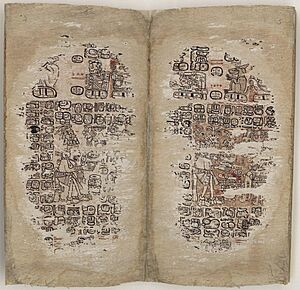
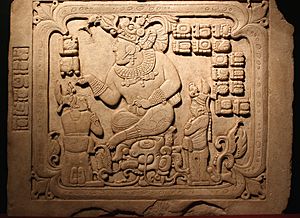
The Maya writing system is one of the outstanding achievements of the pre-Columbian inhabitants of the Americas. It was the most sophisticated and highly developed writing system of more than a dozen systems that developed in Mesoamerica. The earliest inscriptions in an identifiably Maya script date back to 300–200 BC, in the Petén Basin. However, this is preceded by several other Mesoamerican writing systems, such as the Epi-Olmec and Zapotec scripts. Early Maya script had appeared on the Pacific coast of Guatemala by the late 1st century AD, or early 2nd century. Similarities between the Isthmian script and Early Maya script of the Pacific coast suggest that the two systems developed in tandem. By about AD 250, the Maya script had become a more formalised and consistent writing system.
The Catholic Church and colonial officials, notably Bishop Diego de Landa, destroyed Maya texts wherever they found them, and with them the knowledge of Maya writing, but by chance four uncontested pre-Columbian books dated to the Postclassic period have been preserved. These are known as the Madrid Codex, the Dresden Codex, the Paris Codex and the Maya Codex of Mexico (previously known as the Grolier Codex, which was of disputed authenticity until 2018). Archaeology conducted at Maya sites often reveals other fragments, rectangular lumps of plaster and paint chips which were codices; these tantalizing remains are, however, too severely damaged for any inscriptions to have survived, most of the organic material having decayed. In reference to the few extant Maya writings, Michael D. Coe stated:
[O]ur knowledge of ancient Maya thought must represent only a tiny fraction of the whole picture, for of the thousands of books in which the full extent of their learning and ritual was recorded, only four have survived to modern times (as though all that posterity knew of ourselves were to be based upon three prayer books and 'Pilgrim's Progress').
—Michael D. Coe, The Maya, London: Thames and Hudson, 6th ed., 1999, pp. 199–200.
Most surviving pre-Columbian Maya writing dates to the Classic period and is contained in stone inscriptions from Maya sites, such as stelae, or on ceramics vessels. Other media include the aforementioned codices, stucco façades, frescoes, wooden lintels, cave walls, and portable artefacts crafted from a variety of materials, including bone, shell, obsidian, and jade.
Writing system
The Maya writing system (often called hieroglyphs from a superficial resemblance to Ancient Egyptian writing) is a logosyllabic writing system, combining a syllabary of phonetic signs representing syllables with logogram representing entire words. Among the writing systems of the Pre-Columbian New World, Maya script most closely represents the spoken language. At any one time, no more than around 500 glyphs were in use, some 200 of which (including variations) were phonetic.
The Maya script was in use up to the arrival of the Europeans, its use peaking during the Classic Period. In excess of 10,000 individual texts have been recovered, mostly inscribed on stone monuments, lintels, stelae and ceramics. The Maya also produced texts painted on a form of paper manufactured from processed tree-bark generally now known by its Nahuatl-language name amatl used to produce codices. The skill and knowledge of Maya writing persisted among segments of the population right up to the Spanish conquest. The knowledge was subsequently lost, as a result of the impact of the conquest on Maya society.
The decipherment and recovery of the knowledge of Maya writing has been a long and laborious process. Some elements were first deciphered in the late 19th and early 20th century, mostly the parts having to do with numbers, the Maya calendar, and astronomy. Major breakthroughs were made from the 1950s to 1970s, and accelerated rapidly thereafter. By the end of the 20th century, scholars were able to read the majority of Maya texts, and ongoing work continues to further illuminate the content.
Logosyllabic script

The basic unit of Maya logosyllabic text is the glyph block, which transcribes a word or phrase. The block is composed of one or more individual glyphs attached to each other to form the glyph block, with individual glyph blocks generally being separated by a space. Glyph blocks are usually arranged in a grid pattern. For ease of reference, epigraphers refer to glyph blocks from left to right alphabetically, and top to bottom numerically. Thus, any glyph block in a piece of text can be identified. C4 would be third block counting from the left, and the fourth block counting downwards. If a monument or artefact has more than one inscription, column labels are not repeated, rather they continue in the alphabetic series; if there are more than 26 columns, the labelling continues as A', B', etc. Numeric row labels restart from 1 for each discrete unit of text.
Although Mayan text may be laid out in varying manners, generally it is arranged into double columns of glyph blocks. The reading order of text starts at the top left (block A1), continues to the second block in the double-column (B1), then drops down a row and starts again from the left half of the double column (A2), and thus continues in zig-zag fashion. Once the bottom is reached, the inscription continues from the top left of the next double column (C1). Where an inscription ends in a single (unpaired) column, this final column is usually read straight downwards.
Individual glyph blocks may be composed of a number of elements. These consist of the main sign, and any affixes. Main signs represent the major element of the block, and may be a noun, verb, adverb, adjective, or phonetic sign. Some main signs are abstract, some are pictures of the object they represent, and others are "head variants", personifications of the word they represent. Affixes are smaller rectangular elements, usually attached to a main sign, although a block may be composed entirely of affixes. Affixes may represent a wide variety of speech elements, including nouns, verbs, verbal suffixes, prepositions, and pronouns. Small sections of a main sign could be used to represent the whole main sign. Maya scribes were highly inventive in their usage and adaptation of glyph elements.
Writing tools
Although the archaeological record does not provide examples of brushes or pens, analysis of ink strokes on the Postclassic codices suggests that it was applied with a brush with a tip fashioned from pliable hair. A Classic period sculpture from Copán, Honduras, depicts a scribe with an inkpot fashioned from a conch shell. Excavations at Aguateca uncovered a number of scribal artefacts from the residences of elite status scribes, including palettes and mortars and pestles.
Scribes and literacy
Commoners were illiterate; scribes were drawn from the elite. It is not known if all members of the aristocracy could read and write, although at least some women could, since there are representations of female scribes in Maya art. Maya scribes were called aj tzʼib, meaning "one who writes or paints". There were probably scribal schools where members of the aristocracy were taught to write. Scribal activity is identifiable in the archaeological record; Jasaw Chan Kʼawiil I, king of Tikal, was interred with his paint pot. Some junior members of the Copán royal dynasty have also been found buried with their writing implements. A palace at Copán has been identified as that of a noble lineage of scribes; it is decorated with sculpture that includes figures holding ink pots.
Although not much is known about Maya scribes, some did sign their work, both on ceramics and on stone sculpture. Usually, only a single scribe signed a ceramic vessel, but multiple sculptors are known to have recorded their names on stone sculpture; eight sculptors signed one stela at Piedras Negras. However, most works remained unsigned by their artists.
Mathematics
In common with the other Mesoamerican civilizations, the Maya used a base 20 (vigesimal) system. The bar-and-dot counting system that is the base of Maya numerals was in use in Mesoamerica by 1000 BC; the Maya adopted it by the Late Preclassic, and added the symbol for zero. This may have been the earliest known occurrence of the idea of an explicit zero worldwide, although it may have been later than the Babylonian system. The earliest explicit use of zero occurred on monuments dated to 357 AD. In its earliest uses, the zero served as a place holder, indicating an absence of a particular calendrical count. This later developed into a numeral that was used to perform calculation, and was used in hieroglyphic texts for more than a thousand years, until the writing system was extinguished by the Spanish.
The basic number system consists of a dot to represent one, and a bar to represent five. By the Postclassic period a shell symbol represented zero; during the Classic period other glyphs were used. The Maya numerals from 0 to 19 used repetitions of these symbols. The value of a numeral was determined by its position; as a numeral shifted upwards, its basic value multiplied by twenty. In this way, the lowest symbol would represent units, the next symbol up would represent multiples of twenty, and the symbol above that would represent multiples of 400, and so on. For example, the number 884 would be written with four dots on the lowest level, four dots on the next level up, and two dots on the next level after that, to give 4×1 + 4×20 + 2×400 = 884. Using this system, the Maya were able to record huge numbers. Simple addition could be performed by summing the dots and bars in two columns to give the result in a third column.
Calendar
The Maya calendrical system, in common with other Mesoamerican calendars, had its origins in the Preclassic period. However, it was the Maya that developed the calendar to its maximum sophistication, recording lunar and solar cycles, eclipses and movements of planets with great accuracy. In some cases, the Maya calculations were more accurate than equivalent calculations in the Old World; for example, the Maya solar year was calculated to greater accuracy than the Julian year. The Maya calendar was intrinsically tied to Maya ritual, and it was central to Maya religious practices. The calendar combined a non-repeating Long Count with three interlocking cycles, each measuring a progressively larger period. These were the 260-day tzolkʼin, the 365-day haabʼ, and the 52-year Calendar Round, resulting from the combination of the tzolkʼin with the haab'. There were also additional calendric cycles, such as an 819-day cycle associated with the four quadrants of Maya cosmology, governed by four different aspects of the god Kʼawiil.
The basic unit in the Maya calendar was one day, or kʼin, and 20 kʼin grouped to form a winal. The next unit, instead of being multiplied by 20, as called for by the vigesimal system, was multiplied by 18 in order to provide a rough approximation of the solar year (hence producing 360 days). This 360-day year was called a tun. Each succeeding level of multiplication followed the vigesimal system.
| Period | Calculation | Span | Years (approx.) |
|---|---|---|---|
| kʼin | 1 day | 1 day | |
| winal | 1 x 20 | 20 days | |
| tun | 20 x 18 | 360 days | 1 year |
| kʼatun | 20 x 18 x 20 | 7,200 days | 20 years |
| bakʼtun | 20 x 18 x 20 x 20 | 144,000 days | 394 years |
| piktun | 20 x 18 x 20 x 20 x 20 | 2,880,000 days | 7,885 years |
| kalabtun | 20 x 18 x 20 x 20 x 20 x 20 | 57,600,000 days | 157,700 years |
| kinchiltun | 20 x 18 x 20 x 20 x 20 x 20 x 20 | 1,152,000,000 days | 3,154,004 years |
| alawtun | 20 x 18 x 20 x 20 x 20 x 20 x 20 x 20 | 23,040,000,000 days | 63,080,082 years |
The 260-day tzolkʼin provided the basic cycle of Maya ceremony, and the foundations of Maya prophecy. No astronomical basis for this count has been proved, and it may be that the 260-day count is based on the human gestation period. This is reinforced by the use of the tzolkʼin to record dates of birth, and provide corresponding prophecy. The 260-day cycle repeated a series of 20-day-names, with a number from 1 to 13 prefixed to indicated where in the cycle a particular day occurred.
The 365-day haab was produced by a cycle of eighteen named 20-day winals, completed by the addition of a 5-day period called the wayeb. The wayeb was considered to be a dangerous time, when the barriers between the mortal and supernatural realms were broken, allowing malignant deities to cross over and interfere in human concerns. In a similar way to the tzʼolkin, the named winal would be prefixed by a number (from 0 to 19), in the case of the shorter wayeb period, the prefix numbers ran 0 to 4. Since each day in the tzʼolkin had a name and number (e.g. 8 Ajaw), this would interlock with the haab, producing an additional number and name, to give any day a more complete designation, for example 8 Ajaw 13 Keh. Such a day name could only recur once every 52 years, and this period is referred to by Mayanists as the Calendar Round. In most Mesoamerican cultures, the Calendar Round was the largest unit for measuring time.
As with any non-repeating calendar, the Maya measured time from a fixed start point. The Maya set the beginning of their calendar as the end of a previous cycle of bakʼtuns, equivalent to a day in 3114 BC. This was believed by the Maya to be the day of the creation of the world in its current form. The Maya used the Long Count Calendar to fix any given day of the Calendar Round within their current great Piktun cycle consisting of either 20 bakʼtuns. There was some variation in the calendar, specifically texts in Palenque demonstrate that the piktun cycle that ended in 3114 BC had only 13 bakʼtuns, but others used a cycle of 13 + 20 bakʼtun in the current piktun. Additionally, there may have been some regional variation in how these exceptional cycles were managed.
A full long count date consisted of an introductory glyph followed by five glyphs counting off the number of bakʼtuns, katʼuns, tuns, winals, and kʼins since the start of the current creation. This would be followed by the tzʼolkin portion of the Calendar Round date, and after a number of intervening glyphs, the Long Count date would end with the Haab portion of the Calendar Round date.
Correlation of the Long Count calendar
Although the Calendar Round is still in use today, the Maya started using an abbreviated Short Count during the Late Classic period. The Short Count is a count of 13 kʼatuns. The Book of Chilam Balam of Chumayel contains the only colonial reference to classic long-count dates. The most generally accepted correlation is the Goodman-Martínez-Thompson, or GMT, correlation. This equates the Long Count date 11.16.0.0.0 13 Ajaw 8 Xul with the Gregorian date of 12 November 1539. Epigraphers Simon Martin and Nikolai Grube argue for a two-day shift from the standard GMT correlation. The Spinden Correlation would shift the Long Count dates back by 260 years; it also accords with the documentary evidence, and is better suited to the archaeology of the Yucatán Peninsula, but presents problems with the rest of the Maya region. The George Vaillant Correlation would shift all Maya dates 260 years later, and would greatly shorten the Postclassic period. Radiocarbon dating of dated wooden lintels at Tikal supports the GMT correlation.
Astronomy
The Maya made meticulous observations of celestial bodies. This information was used for divination, so Maya astronomy was essentially for astrological purposes. Although Maya astronomy was mainly used by the priesthood to comprehend past cycles of time, and project them into the future to produce prophecy, it also had some practical applications, such as providing aid in crop planting and harvesting. The priesthood refined observations and recorded eclipses of the sun and moon, and movements of Venus and the stars; these were measured against dated events in the past, on the assumption that similar events would occur in the future when the same astronomical conditions prevailed. Illustrations in the codices show that priests made astronomical observations using the naked eye, assisted by crossed sticks as a sighting device. Analysis of the few remaining Postclassic codices has revealed that, at the time of European contact, the Maya had recorded eclipse tables, calendars, and astronomical knowledge that was more accurate at that time than comparable knowledge in Europe.
The Maya measured the 584-day Venus cycle with an error of just two hours. Five cycles of Venus equated to eight 365-day haab calendrical cycles, and this period was recorded in the codices. The Maya also followed the movements of Jupiter, Mars and Mercury. When Venus rose as the Morning Star, this was associated with the rebirth of the Maya Hero Twins. For the Maya, the heliacal rising of Venus was associated with destruction and upheaval. Venus was closely associated with warfare, and the hieroglyph meaning "war" incorporated the glyph-element symbolizing the planet. Sight-lines through the windows of the Caracol building at Chichen Itza align with the northernmost and southernmost extremes of Venus' path. Maya rulers launched military campaigns to coincide with the heliacal or cosmical rising of Venus, and would also sacrifice important captives to coincide with such conjunctions.
Solar and lunar eclipses were considered to be especially dangerous events that could bring catastrophe upon the world. In the Dresden Codex, a solar eclipse is represented by a serpent devouring the kʼin ("day") hieroglyph. Eclipses were interpreted as the sun or moon being bitten, and lunar tables were recorded in order that the Maya might be able to predict them, and perform the appropriate ceremonies to ward off disaster.
Religion and mythology
In common with the rest of Mesoamerica, the Maya believed in a supernatural realm inhabited by an array of powerful deities who needed to be placated with ceremonial offerings and ritual practices. At the core of Maya religious practice was the worship of deceased ancestors, who would intercede for their living descendants in dealings with the supernatural realm. The earliest intermediaries between humans and the supernatural were shamans.
The Maya viewed the cosmos as highly structured. There were thirteen levels in the heavens and nine in the underworld, with the mortal world in between. Each level had four cardinal directions associated with a different colour; north was white, east was red, south was yellow, and west was black. Major deities had aspects associated with these directions and colours.
Maya households interred their dead underneath the floors, with offerings appropriate to the social status of the family. There the dead could act as protective ancestors. Maya lineages were patrilineal, so the worship of a prominent male ancestor would be emphasised, often with a household shrine. As Maya society developed, and the elite became more powerful, Maya royalty developed their household shrines into the great pyramids that held the tombs of their ancestors.
Belief in supernatural forces pervaded Maya life, from the simplest day-to-day activities such as cooking, to trade, politics, and elite activities. Maya deities governed all aspects of the world, both visible and invisible. The Maya priesthood was a closed group, drawing its members from the established elite; by the Early Classic they were recording increasingly complex ritual information in their hieroglyphic books, including astronomical observations, calendrical cycles, history and mythology. The priests performed public ceremonies that incorporated feasting, bloodletting, incense burning, music, ritual dance, and, on certain occasions, human sacrifice. During the Classic period, the Maya ruler was the high priest, and the direct conduit between mortals and the gods. It is highly likely that, among commoners, shamanism continued in parallel to state religion. By the Postclassic, religious emphasis had changed; there was an increase in worship of the images of deities, and more frequent recourse to human sacrifice.
Deities
The Maya world was populated by a great variety of deities, supernatural entities and sacred forces. The Maya had such a broad interpretation of the sacred that identifying distinct deities with specific functions is inaccurate. The Maya interpretation of deities was closely tied to the calendar, astronomy, and their cosmology. The importance of a deity, its characteristics, and its associations varied according to the movement of celestial bodies. The priestly interpretation of astronomical records and books was therefore crucial, since the priest would understand which deity required ritual propitiation, when the correct ceremonies should be performed, and what would be an appropriate offering. Each deity had four manifestations, associated with the cardinal directions, each identified with a different colour. They also had a dual day-night/life-death aspect.
Itzamna was the creator god, but he also embodied the cosmos, and was simultaneously a sun god; Kʼinich Ahau, the day sun, was one of his aspects. Maya kings frequently identified themselves with Kʼinich Ahau. Itzamna also had a night sun aspect, the Night Jaguar, representing the sun in its journey through the underworld. The four Pawatuns supported the corners of the mortal realm; in the heavens, the Bacabs performed the same function. As well as their four main aspects, the Bakabs had dozens of other aspects that are not well understood. The four Chaacs were storm gods, controlling thunder, lightning, and the rains. The nine lords of the night each governed one of the underworld realms. Other important deities included the moon goddess, the maize god, and the Hero Twins.
The Popol Vuh was written in the Latin script in early colonial times, and was probably transcribed from a hieroglyphic book by an unknown Kʼicheʼ Maya nobleman. It is one of the most outstanding works of indigenous literature in the Americas. The Popul Vuh recounts the mythical creation of the world, the legend of the Hero Twins, and the history of the Postclassic Kʼicheʼ kingdom. Deities recorded in the Popul Vuh include Hun Hunahpu, believed by some to be the Kʼicheʼ maize god, and a triad of deities led by the Kʼicheʼ patron Tohil, and also including the moon goddess Awilix, and the mountain god Jacawitz.
In common with other Mesoamerican cultures, the Maya worshipped feathered serpent deities. Such worship was rare during the Classic period, but by the Postclassic the feathered serpent had spread to both the Yucatán Peninsula and the Guatemalan Highlands. In Yucatán, the feathered serpent deity was Kukulkan, among the Kʼicheʼ it was Qʼuqʼumatz. Kukulkan had his origins in the Classic period War Serpent, Waxaklahun Ubah Kan, and has also been identified as the Postclassic version of the Vision Serpent of Classic Maya art. Although the cult of Kukulkan had its origins in these earlier Maya traditions, the worship of Kukulkan was heavily influenced by the Quetzalcoatl cult of central Mexico. Likewise, Qʼuqʼumatz had a composite origin, combining the attributes of Mexican Quetzalcoatl with aspects of the Classic period Itzamna.
Agriculture
The ancient Maya had diverse and sophisticated methods of food production. It was believed that shifting cultivation (swidden) agriculture provided most of their food, but it is now thought that permanent raised fields, terracing, intensive gardening, forest gardens, and managed fallows were also crucial to supporting the large populations of the Classic period in some areas. Indeed, evidence of these different agricultural systems persist today: raised fields connected by canals can be seen on aerial photographs. Contemporary rainforest species composition has significantly higher abundance of species of economic value to ancient Maya in areas that were densely populated in pre-Columbian times, and pollen records in lake sediments suggest that maize, manioc, sunflower seeds, cotton, and other crops have been cultivated in association with deforestation in Mesoamerica since at least 2500 BC.
The basic staples of the Maya diet were maize, beans, and squashes. These were supplemented with a wide variety of other plants either cultivated in gardens or gathered in the forest. At Joya de Cerén, a volcanic eruption preserved a record of foodstuffs stored in Maya homes, among them were chilies and tomatoes. Cotton seeds were in the process of being ground, perhaps to produce cooking oil. In addition to basic foodstuffs, the Maya also cultivated prestige crops such as cotton, cacao and vanilla. Cacao was especially prized by the elite, who consumed chocolate beverages. Cotton was spun, dyed, and woven into valuable textiles in order to be traded.
The Maya had few domestic animals; dogs were domesticated by 3000 BC, and the Muscovy duck by the Late Postclassic. Ocellated turkeys were unsuitable for domestication, but were rounded up in the wild and penned for fattening. All of these were used as food animals; dogs were additionally used for hunting. It is possible that deer were also penned and fattened.
Maya sites
There are hundreds of Maya sites spread across five countries: Belize, El Salvador, Guatemala, Honduras and Mexico. The six sites with particularly outstanding architecture or sculpture are Chichen Itza, Palenque, Uxmal, and Yaxchilan in Mexico, Tikal in Guatemala and Copán in Honduras. Other important, but difficult to reach, sites include Calakmul and El Mirador. The principal sites in the Puuc region, after Uxmal, are Kabah, Labna, and Sayil. In the east of the Yucatán Peninsula are Coba and the small site of Tulum. The Río Bec sites of the base of the peninsula include Becan, Chicanná, Kohunlich, and Xpuhil. The most noteworthy sites in Chiapas, other than Palenque and Yaxchilan, are Bonampak and Toniná. In the Guatemalan Highlands are Iximche, Kaminaljuyu, Mixco Viejo, and Qʼumarkaj (also known as Utatlán). In the northern Petén lowlands of Guatemala there are many sites, though apart from Tikal access is generally difficult. Some of the Petén sites are Dos Pilas, Seibal, and Uaxactún. Important sites in Belize include Altun Ha, Caracol, and Xunantunich.
Museum collections

There are many museums across the world with Maya artefacts in their collections. The Foundation for the Advancement of Mesoamerican Studies lists over 250 museums in its Maya Museum database, and the European Association of Mayanists lists just under 50 museums in Europe alone.
Images for kids
-
Remains in Joya de Cerén, a Classic-era settlement in El Salvador buried under volcanic ash around 600 AD. Its preservation has greatly helped in the study of everyday life in a Maya farming community.
-
Stela D from Quiriguá, representing king Kʼakʼ Tiliw Chan Yopaat
-
Chichen Itza was the most important city in the northern Maya region.
-
Mayapan was an important Postclassic city in the northern Yucatán Peninsula.
-
Page from the Lienzo de Tlaxcala showing the Spanish conquest of Iximche, known as Cuahtemallan in the Nahuatl language
-
Drawing by Frederick Catherwood of the Nunnery complex at Uxmal
-
1892 photograph of the Castillo at Chichen Itza, by Teoberto Maler
See also
 In Spanish: Cultura maya para niños
In Spanish: Cultura maya para niños


